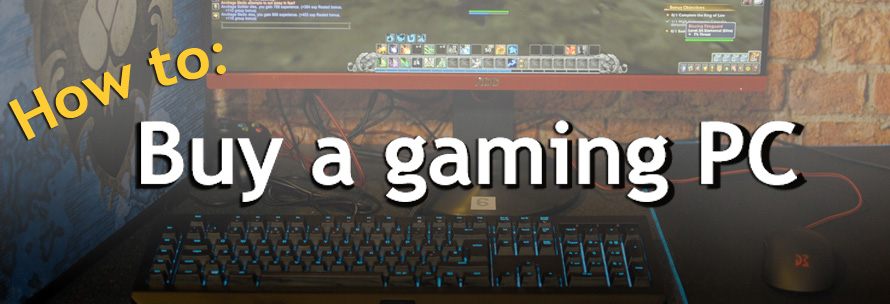How to Buy a Gaming PC

If you’ve established that you need a gaming PC, either for yourself or for the younger gamers in your family, but you have no idea what’s involved and don’t know where to turn, then this guide is for you!
The bad news is, it is a little more complicated than just picking up an XBox at the supermarket and plugging it into your TV. The good news is, there is more scope for customisation and more flexibility with a PC over a console, and we can help with all the technical bits and help you find what you need. However, first it does need a little bit of exploring options to establish your requirements.
“What kind of computer do I need?”

We see a lot of enquiries along the lines of “my kid is 12 wants a gaming PC, how much are they”, but it’s a little bit more complex than a fixed answer or price, remember I was saying it was more complicated than an Xbox, right? Part of that is the lack of one-size-fits-all ready-made price structure.
First of all, computers (for gaming or otherwise) come in many different performance levels and price points, in the same respect that someone wanting to type a letter needs only a basic cheap one, compared to someone editing high-resolution video or doing 3D design work needs something powerful and expensive. Games cover a wide spectrum, and so while a customer just wanting to play games with simpler graphics (Roblox or Counterstrike for instance) can get away with a lower-end PC, those wanting to play games with a lot of graphics detail (Call of Duty, Cyberpunk 2077, VR games) need something higher-end or more expensive.
On our system quote form (link), this is the very first detail we ask : which games do you want to play? It’s pretty important to have some idea on this as there’s no use getting a computer that’s not powerful enough for the job. This is the quickest method for ensuring we are getting the baseline, minimum performance right for you.
The method we advise this by is showing a set of scores for games you’re interested in. Here’s an example :

There’s two main parts of a computer that affect gaming performance – the processor (CPU) and Graphics Card (Gfx). The numbers above represent performance levels for each, and are a linear score using a tool ‘Passmark’ that gives a valuation on computer performance. The minimum scores for both CPU and Gfx are the lowest performance scores you’ll get away with to play the game at all (typically at lower detail levels) and the recommended scores show the performance level your PC would need to turn the detail settings up high and still play smoothly.
See how the scores for Minecraft are quite low, and the Call of Duty scores are much higher? Just like I said a moment ago, this reflects that some games need a more powerful PC, and you’ll see there’s plenty of games that sit somewhere in the middle like Fortnite and Valorant.
So whenever we show an example PC on the website (whether new or refurbished), whenever we draw up a quote or an upgrade recommendation for you, or show options in a quote as to how changing an item will affect the performance. We use these scores to make it crystal clear how relevant the computer is. For instance, a computer with 5000 points CPU and Gfx scores would be great for Minecraft, fairly good for Fortnite but wouldn’t play Call of Duty very well.
This is why we ask which games you want to play – just so we can make sure (and show you why) a given computer specification would be relevant and suitable for your needs.
“What will this cost?”
We realise and understand not everyone approaches this with a clear figure in mind of where they want to spend. If you do set a target budget, it’s something we’ll try to work to, within reason of course, can’t always work miracles, but if something won’t work we’ll at least let you know and try and find some balance.
Naturally though it will be a scenario quite often that there’s no idea of where to aim for cost wise, and while it’s not possible to cover every scenario in a couple of paragraphs, will at least try and give some insight.
Kustom PCs offer both new / custom-built systems (which will have the best future-proofing in terms of upgrades and long 3 years warranty) and these can be set up how you like in terms of things like storage as well as more cosmetic changes, such as case style and lighting. The cost does vary, but we show example systems on the website here and as a ballpark cost for the tower only –
Around £550 – Entry level gaming PC for games like Roblox, Minecraft and Counterstrike
£680-£750 – reasonable performance and better suited to slightly more demanding titles like Fortnite, Apex Legends, Valorant, Rainbow Six Siege
£750-£950 – in this territory you’ll be able to play pretty much every game on the market just now, and fairly well too, you need to be in this territory as a realistic minimum to play titles like Call of Duty, Cyberpunk 2077 etc
£950-£1200 – high performance systems that will run all current games at high levels of detail including the above.
£1200 + Above – needed for the most demanding situations, such as with higher performance monitors / streaming PCs, Flight Simulation and so on – but really varies to suit.
These costs are for the computer tower – we may need to plug some other bits into that which will be covered below in a moment.
If you’ve had a fright already, and had hoped to see some slightly lower numbers, this would be a great time to point out that we also offer reconditioned PCs for gaming too. Typically these are more performance for your money but have a shorter warranty and may not always be as upgradable as a totally new system, but for instance we regularly have stock of systems at £300-£350 that are ideal for Minecraft / Fortnite / Rainbow Six and then systems around £500-£600 that will play Call of Duty perfectly well, so these can often be a good bet if your target spend is lower and just want to get started with less of an outlay.
“And the other bits alongside the tower”

With a laptop computer you would usually have all the bits you need in the one package (the computer, screen, keyboard, pointing device are all in one unit together) but with a desktop PC for gaming you add those separately.
First up, the monitor: sometimes if you need the lowest cost method to get up and running, using a TV with an HDMI connection is often fine, but it might not be comfortable to sit and work at. It is an option that some may consider to be 'free' though if there's already one there for use with a console.
As well as sitting more easily on most desks, computer monitors while smaller tend to be ‘faster’ than most TVs so are often the preference for playing games with ( A ‘slow’ screen will cause a smear when there is fast motion, such as moving around in a game. In competitive games like Call of Duty or Fortnite, it can mean the difference between hitting your target or missing altogether! )
Cost of these varies, and while some small / general use monitors start at about £70, typically you’re looking at £95 or above for monitors more suited for gaming. This can go higher, typically with £200 then achieving models with much faster refresh rates and suited for those playing competitive esports games.
There's a few typical variables - most monitors (and this applies to all below) are 1920 x 1080 (Full HD) resolution, and so the differences in the monitors listed below are size, response time and refresh rate.
Lower response times are better for high-speed games, and the higher refresh rate means the screen updates more times per second for a smoother image when moving around quickly. Size should be a fairly obvious difference!
Monitors can easily go above this in cost with higher resolutions combined with faster refresh rates available, but typically these come into play with specific requirements and are not usually a concern with an introduction in PC gaming. Useful tip - an entry level monitor can still be useful later, repurposed as a second screen for chat / videos while gaming on another monitor. So even if aspirations and budget for a high-end monitor don't align at first, a more basic monitor is not neccesarily a waste as it can become the secondary screen in future if a higher performance one is added as the primary gaming screen.
Here are four of our popular options ( costs shown are at the time of writing this blog and may vary a little in time ) -

- AOC E2270SWDN = £94.80 – 21.5" Size, 60Hz refresh, 5ms pixel response
- Iiyama G2440HSU-B1 = £132.00 – 23.6" Size, 75Hz refresh, 1ms pixel response, includes speakers.
- AOC G2590VXQ = £140.40 – 24.5" Size, 75Hz refresh, 1ms pixel response, includes speakers.
- AOC 24G2AE/BK = £186.00 – 24" Size, 144Hz refresh, 1ms pixel response, includes speakers.
Keyboard and Mouse: Like many areas there's loads of these, and you can spend anything from £10 to £300 on a pairing of keyboard and mouse. Of course, anything in the higher end you usually will approach with some particular specifics of what is required.
If you're buying an entry point for yourself or as a gift then it often makes sense to start basic and then in future you (or your recipient!) will probably have a better mindset




















































